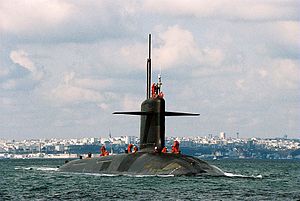
The Force de dissuasion, known as the Force de frappe prior to 1961, is the French nuclear deterrence force. The Force de dissuasion used to be a triad of air-, sea- and land-based nuclear weapons intended for dissuasion, the French term for deterrence. Following the end of the Cold War, France decommissioned all its land-based nuclear missiles, thus the Force de dissuasion today only incorporates an air- and sea-based arsenal.

The Air-Sol Moyenne Portée or ASMP is a French nuclear-armed air-launched cruise missile manufactured by MBDA France. In French nuclear doctrine, it serves what is referred to as a "pre-strategic" deterrence role. It is intended to be the ultimate "warning shot" prior to the full-scale employment of the strategic nuclear weapons arming the Triomphant-class ballistic missile submarines. The missile's development was undertaken by Aérospatiale's missile systems division, whose assets are now part of MBDA.
The M51 SLBM is a French submarine-launched ballistic missile, built by ArianeGroup, and deployed with the French Navy. Designed to replace the M45 SLBM, it was first deployed in 2010.
The Suffren class is a class of nuclear attack submarines, designed by the French shipbuilder Naval Group for the French Navy. It is intended to replace the Rubis-class submarines. Construction began in 2007 and the first unit was commissioned on 6 November 2020. The lead boat of the class, Suffren, entered service on 3 June 2022.

His Majesty's Naval Base, Clyde, primarily sited at Faslane on the Gare Loch, is one of three operating bases in the United Kingdom for the Royal Navy. It is the navy's headquarters in Scotland and is best known as the home of Britain's nuclear weapons, in the form of nuclear submarines armed with Trident missiles.

The Rubis class is a class of nuclear-powered attack submarines operated by the French Navy. It comprises six boats, the first entering service in 1983 and the last in 1993. Two additional units originally planned were cancelled as a result of post-Cold War budget cuts. All six submarines of the Rubis class are based at Toulon and are part of the Escadrille de sous-marins nucléaires d'attaque. Smaller than contemporary designs of other major world navies, the Rubis class shares many of its system designs with the conventionally-powered Agosta class. In the late 1980s, the Rubis class was proposed to Canada in the context of their plan to acquire nuclear-powered submarines.

Le Rubis, initially named Provence, was a first-generation nuclear attack submarine and lead boat of the Rubis class of the French Navy, assigned to the attack nuclear submarine squadron.
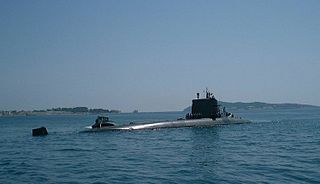
Perle is a first-generation nuclear attack submarine of the French Navy. The boat is the sixth and last of the Rubis series. Construction began on the submarine on 27 March 1987. The boat was launched on 22 September 1990 and entered active duty service on 7 July 1993.
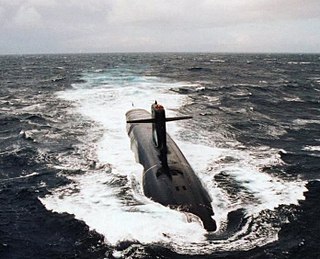
The Strategic Ocean Force has been the synonym of the French Submarine Forces since 1999, which the commandant commands the ensemble related to, along with the squadron of nuclear attack submarine.
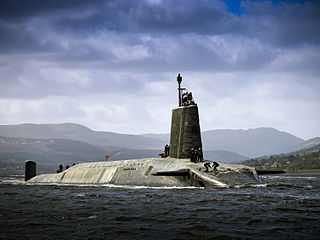
HMSVigilant is the third Vanguard-class submarine of the Royal Navy. Vigilant carries the Trident ballistic missile, the United Kingdom's nuclear deterrent.
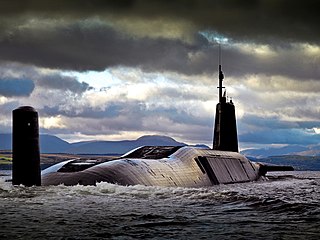
HMS Vengeance is the fourth and final Vanguard-class submarine of the Royal Navy. Vengeance carries the Trident ballistic missile, the UK's nuclear deterrent.

A nuclear triad is a three-pronged military force structure of land-based intercontinental ballistic missiles (ICBMs), submarine-launched ballistic missiles (SLBMs), and strategic bombers with nuclear bombs and missiles. Countries build nuclear triads to eliminate an enemy's ability to destroy a nation's nuclear forces in a first-strike attack, which preserves their own ability to launch a second strike and therefore increases their nuclear deterrence.

The Triomphant class of ballistic missile submarines of the French Navy is the active lead boat class of four boats that entered service in 1997, 1999, 2004, and 2010. These four superseded the older Redoutable class, and they provide the ocean-based component of France's nuclear deterrent strike force, the Force de dissuasion. Their home port is Île Longue, Roadstead of Brest, Western Brittany.

Le Triomphant is a strategic nuclear submarine of the French Navy; the submarine is the lead boat of her class commissioned in 1997 with the home port of Île Longue. The vessel carries sixteen strategic missiles, whose launch can only be authorized by the President of France.

Le Téméraire is a Triomphant-class ballistic missile submarine of the French Navy, launched in January 1998, and commissioned in December 1999, six months behind schedule. The boat had, in May 1999, successfully test launched an M45 submarine-launched ballistic missile.
Le Terrible is a Triomphant-class strategic nuclear submarine of the French Navy. The boat was launched on 21 March 2008

The Submarine Forces of France are one of the four main components of the French Navy. The force oversees all French submarines regardless of role.
The Tête nucléaire océanique or TNO is a French thermonuclear warhead designed to equip the M51 ballistic missiles on the Triomphant-class submarines. It has been in service since 2016, replacing the TN 75 warhead, originally designed for the M45, and which also equipped the M51, pending the development and service entry of the TNO.
The Missile de Croisière Naval (MdCN), meaning Naval Cruise Missile, is a French turbojet-powered subsonic cruise missile intended for ship and submarine-based land-attack operations. Originally dubbed SCALP Naval, the program arose out of a requirement issued by the French Ministry of Defence for a more potent cruise missile capable of striking strategic and military targets from extended stand-off ranges in order to complement the air-launched SCALP-EG.
Duguay-Trouin (S636) is a French nuclear attack submarine and the second boat of the Suffren class. The vessel was laid down on 26 June 2009 and launched on 9 September 2022 at Cherbourg. It was commissioned on 28 July 2023.
